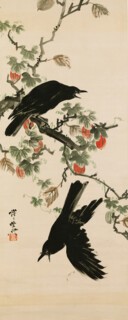The two crows have much to communicate. Kawanabe Kyōsai (1831-89) often painted static crows, but in Two Crows with ‘Crow Gourd’ (c.1884), part of an exhibition of his work from the Israel Goldman Collection at the Royal Academy (until 19 June), he captures the swooping movement of the birds and summons their loud cawing – the sound of wooded areas of Japanese cities at dusk. Unlike many of Kyōsai’s crows, which were sketched on paper, this is painted on silk, which has different qualities of absorbency, and requires the artist to have considerable control of his materials. Kyōsai’s skill with ink is shown in the bleeding of the wet ink within the fruit and leaves, and in the slight areas left in reserve to illustrate the descending bird’s outspread wings. The composition is structured around the strong diagonal of the tree branch, with the crows forming a dynamic balancing act, one on either side.
Kyōsai produced thousands of pictures of animals – many of them are included in Kyōsai’s Animal Circus (RA, £12.95) – and he delighted in their potential for representing human foibles. His identification with crows began in 1881, when he won a prize for a simple painting of a moody crow on a tree stump. The work was bought for 100 yen, then a record price in Japan. The judges gave grudging praise but hinted at their disapproval of Kyōsai’s irreverent attitude and his prodigious consumption of sake. He replied that the price was not for the small labour it took to produce a single work, but for the cumulative years spent mastering his craft. And the sake was Dutch courage; he was in fact modest and shy. Around the same time, the British architect Josiah Conder, a former pupil of Kyōsai’s, helped arrange for him a commission of a hundred crow paintings for the European market. Crows appear everywhere in this exhibition, standing in for Kyōsai himself: hopping about and commenting on the social changes of the day.
His style was the result of both a long apprenticeship in orthodox Kano painting, which served the ruling elite, and an early childhood stint in the studio of Utagawa Kuniyoshi, who produced popular prints and comic pictures. The resulting works combine fine technical ability with vitality and wit. Kyōsai’s art is both out of time and responsive to its time, calling out to us today – human, animal – like those noisy crows.
Send Letters To:
The Editor
London Review of Books,
28 Little Russell Street
London, WC1A 2HN
letters@lrb.co.uk
Please include name, address, and a telephone number.


